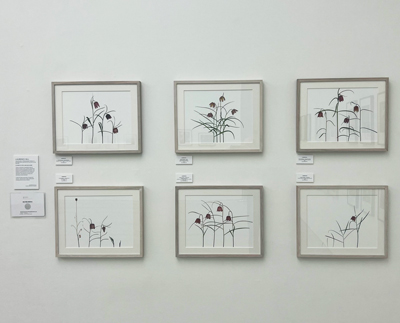NEWS 2023
33 Views of Fritillaria meleagris
Royal Horticultural Society Botanical Art & Photography Show
Laurence Hill
Saatchi Gallery
Duke of York’s HQ
King's Road, London
United Kingdom
16 June – 9 July 2023
Some stories take longer to realise and consequently are seldom explored. Building this collection of Fritillaria meleagris portraits has taken ten years. It’s a plant that is both familiar to many, yet still has much to express.
These six panoramic compositions in 33 Views of Fritillaria meleagris take the observer through cycles of growth, reproduction, external stimuli, and gradations of diversity. They broaden the representational plant image which typically convey taxonomic and horticultural information. Here elements of ecology and physiology are also presented.
Since its conception analogue photography has employed in camera and darkroom techniques to extend the single time point. These composite photographs exploit the digital medium to combine elements taken over days, weeks, and years.
Individual portraits are focus-stacked, then layer-stacked and hand corrected using a pen tablet. In total 157 frames were taken to produce 26 portraits. These had their scales unified before arranging them into the six themes.
Focus-stacking reduces the optical limitations of depth-of-field and brings photographs closer to human perception. Conversely, these photographs do not use linear perspective but are arranged horizontally with limited overlaps. This flattens the images to form a scrolling perspective. These two interventions both push and pull the perception of space.
This exhibit is not just about Fritillaria meleagris, the Snake’s-head fritillary. It’s about how bias arises through visual culture and scientific practice.
Cultural bias - left to right or right to left
Historically in western science charts, graphs, and developmental representations are set left to right. This is the case with the Ontogenesis image but not Annual Life Cycle. The composition is set right to left to fit aesthetically in the overall gallery hang. Equally, as a symbol of these east-west differences that are also present in the distribution of Fritillaria meleagris.
Colour bias - limited exposure to different colour forms of a biological species
Fritillaria meleagris is known as the plant with tessellated flowers. This is the distinctive characteristic that people want to show in their gardens or images. It’s also the form available in horticulture. The darker eastern form lacks this signature, is more difficult to cultivate, and occurs in more remote locations. This can lead to colour bias.
These partialities are the Illusory Truth Effect. By repeatedly being exposed to incorrect information, one can believe only it to be true. For example, political propaganda, advertising slogans or the absence of women and non-whites in professional roles, etc.
The exhibit received a Silver Medal from a panel of experts as some of the colours were perceived as wrong and that some of the plants being represented were at a smaller scale, although it was stated that they were all at the same scale. The judges’ interpretation rather proves the point: this panel of experts lacked awareness of the full biodiversity of this species yet rejected the evidence presented in the six images. The Illusory Truth Effect in action, QED.
The title alludes to levels of seeing. There are 26 individual images, in 6 themed groups in one overall presentation. The question the work asks the viewer is, how do you see Fritillaria meleagris? As a biological unit known only by it’s western members or individuals known only by one collective name?
Click image to download page as a PDF. Related work, 16 Views of Fritillaria meleagris




